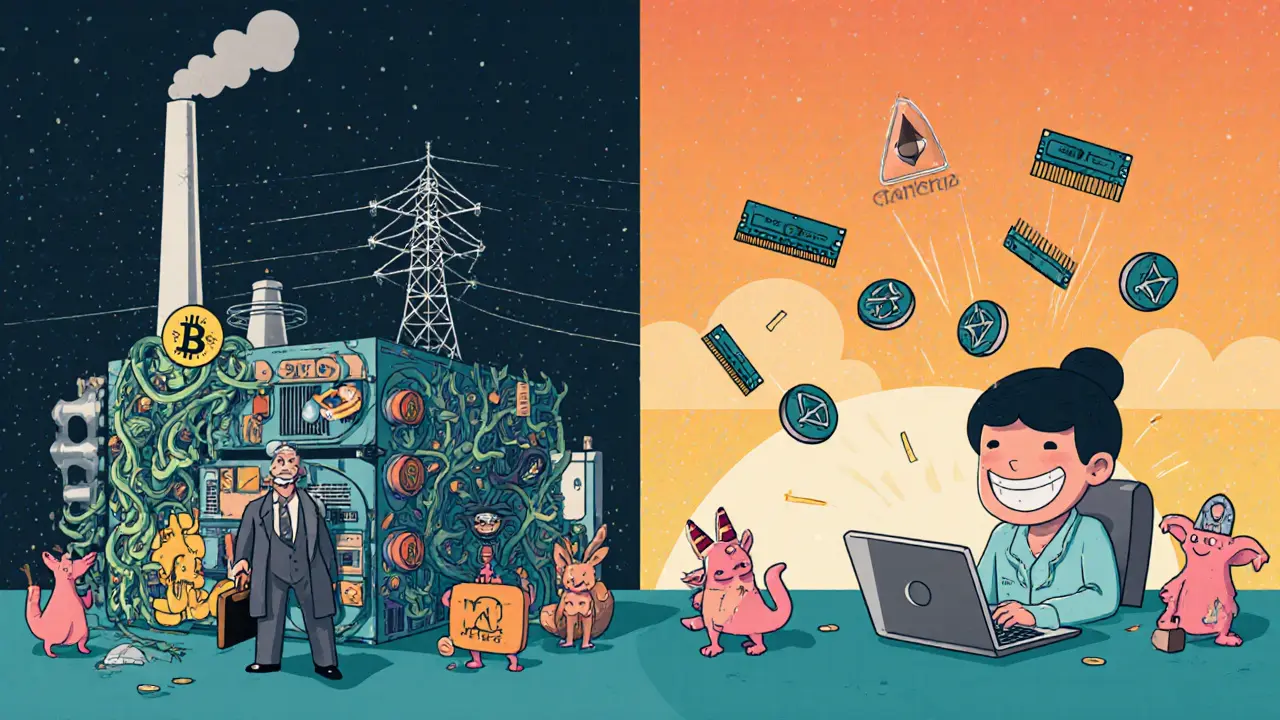Mining Profitability Calculator
Mining Profitability Calculator
Results
Bitcoin Mining
Altcoin Mining
Bitcoin mining in 2025 isn’t what it used to be
Five years ago, you could mine Bitcoin with a gaming GPU and make a decent profit. Today, that’s nearly impossible. The Bitcoin network’s hash rate has exploded, hitting record levels after the April 2024 halving cut block rewards from 6.25 BTC to just 3.125 BTC. That means every miner is getting half the payout for the same amount of work. Meanwhile, the price of Bitcoin has stabilized around $58,000-solid, but far from the $70,000+ peaks of 2021. For individual miners, this isn’t just a setback-it’s a full-on barrier to entry.
Bitcoin mining now demands ASIC hardware. These machines, like the Whatsminer M20S or Bitmain Antminer S21, are built for one thing: solving Bitcoin’s cryptographic puzzles. They’re loud, hot, and power-hungry. A single M20S might generate $10-$15 per day in Bitcoin revenue, but only if you’re paying less than $0.06 per kWh for electricity. Most home users pay $0.12-$0.18. That’s a loss. Even if you buy a used ASIC for $2,000, you’re looking at 18-24 months just to break even-if the price doesn’t drop, and if your electricity doesn’t go up.
And that’s just the start. You need industrial-grade cooling. You need a dedicated circuit. You need to join a mining pool just to get paid regularly. The whole setup costs $10,000 to $50,000 for a small operation. Big players like Core Scientific and Marathon Digital now control over 60% of Bitcoin’s hash rate. They’re buying power directly from power plants in Texas and Kazakhstan. For a hobbyist? It’s like trying to compete with a tanker in a kayak.
Altcoin mining is where the real opportunity is now
While Bitcoin mining turns into a corporate arms race, altcoins are quietly offering a lifeline to smaller miners. You don’t need a warehouse full of ASICs. You don’t need a $50,000 budget. You just need a decent desktop computer.
Take Monero (XMR). It was designed specifically to resist ASICs. Its algorithm, RandomX, runs best on CPUs and GPUs-the same chips in your laptop or gaming rig. You can start mining Monero right now with software like XMRig, no special hardware needed. In 2025, a mid-range Ryzen 7 or RTX 3060 can earn 0.005-0.008 XMR per day. At $150 per XMR, that’s $0.75-$1.20 daily. Sounds small? It’s not. You’re not paying $1,000 in electricity. You’re not replacing fans every month. You’re using hardware you already own.
Litecoin (LTC) is another option. It’s like Bitcoin’s older brother-same code, faster blocks. Litecoin mines every 2.5 minutes instead of 10, so you get paid four times as often. It uses Scrypt, which ASICs can mine efficiently, but the machines are cheaper than Bitcoin’s. A Goldshell LT6 costs around $1,500 and can earn $3-$5 per day in Litecoin. That’s a 6-10 month payback period if your electricity is under $0.08/kWh. Compare that to Bitcoin’s 2-year+ payback, and the math changes.
Then there’s Ethereum Classic (ETC), which still uses Proof of Work after Ethereum switched to Proof of Stake in 2022. It’s not as popular as Monero, but it’s stable, has a loyal community, and can be mined with GPUs. A single RTX 4070 can generate 0.01-0.015 ETC daily. At $20 per ETC, that’s $0.20-$0.30 per day. Still, it’s profitable without needing a power plant.
Hardware: ASICs vs GPUs-why the difference matters
Bitcoin mining is all about ASICs. These are custom chips built for one task. They’re efficient-but only if you’re running them at scale. A single ASIC can consume 3,000 watts. That’s like running a space heater 24/7. You can’t plug it into a regular outlet. You need a 240V circuit. You need to cool it with industrial fans. You need to monitor it constantly.
Altcoins like Monero and Ethereum Classic use algorithms that are memory-hard. That means they need lots of RAM and fast processing, not raw brute force. GPUs are perfect for this. A single RTX 4080 uses 320 watts and can mine Monero at 6,000 H/s. That’s 90% less power than an ASIC, and you can run five of them on a standard home circuit.
Here’s the real win: you can mine altcoins while using your computer for other things. You can browse, stream, or even game while mining Monero in the background. You’re not turning your living room into a server farm. You’re just making use of idle cycles.
And here’s the kicker: altcoin mining hardware doesn’t become obsolete as fast. An ASIC for Bitcoin is useless if the price crashes or the difficulty spikes. But a GPU? You can sell it on eBay, use it for gaming, or switch to mining another coin next month. It’s flexible. Bitcoin hardware? It’s a brick if the math doesn’t work.

Profitability isn’t just about coins-it’s about electricity
Electricity cost is the #1 factor in mining profitability. Period.
For Bitcoin, you need electricity under $0.05/kWh to be competitive. That’s only possible if you’re near cheap hydroelectric dams, natural gas plants, or in countries with loose regulations. In the U.S., that’s mostly Texas, Oklahoma, and parts of Washington. Even then, you need to negotiate bulk rates with utilities. Most people pay $0.12-$0.18. That’s a death sentence for Bitcoin mining at home.
Altcoins? You can still make money at $0.10/kWh. Monero mining on a Ryzen 5 5600X uses 80 watts. At $0.12/kWh, that’s $0.08 per day in electricity. You’re earning $1.00. Profit: $0.92. You’re not just breaking even-you’re winning.
And you don’t need to be a tech wizard. Mining Monero is as simple as downloading XMRig, pasting your wallet address, and hitting run. No complicated pool setups. No firmware flashing. No overheating risks from stacking 20 ASICs in a closet.
Volatility and risk: Bitcoin’s stability vs altcoin’s gamble
Bitcoin is the blue-chip stock of crypto. It’s predictable. It’s liquid. It’s the only cryptocurrency with global institutional backing. But that stability comes at a cost: low reward for high risk. If you’re mining Bitcoin, you’re betting that the price will hold or rise enough to cover your massive overhead. If Bitcoin drops to $40,000, your profit margins vanish.
Altcoins are the startup stocks. Monero’s price can swing 20% in a day. Litecoin can drop 30% after a bad news cycle. But here’s the thing: you don’t need to hold the coin to profit. You can mine it, sell it weekly on Coinbase, and lock in cash. You’re not gambling on long-term price appreciation-you’re turning electricity into cash flow.
Also, altcoins are less likely to be regulated out of existence. Bitcoin is too big to ignore, but Monero? It’s a privacy coin. Governments hate it. But it’s still alive in 2025 because its community refuses to compromise. That’s the kind of resilience you can’t buy with a corporate balance sheet.

Who should mine what?
- Choose Bitcoin mining if: You have $50,000+ to invest, access to under-$0.05/kWh electricity, industrial space, and a team to manage hardware. You’re in it for the long haul, not quick returns.
- Choose altcoin mining if: You have a spare computer, pay $0.08-$0.15/kWh, want to start with $0-$2,000, and prefer flexibility over scale. You’re okay with smaller, more frequent payouts and don’t want to be locked into one machine.
Most people who try Bitcoin mining today quit within 90 days. They don’t realize how much it costs to run. They think, “I’ll just plug it in and make money.” They don’t. But altcoin miners? They’re still around. They’re mining Monero on their old laptops while working from home. They’re turning $50 worth of electricity into $100 of crypto every month. And they’re not stressed about it.
What’s next in 2025?
Bitcoin mining will keep getting harder. More ASICs. More consolidation. More energy lawsuits. The days of the solo miner are over. The network is now a machine owned by corporations and energy giants.
Altcoin mining? It’s the last open frontier. Monero isn’t going PoS. Litecoin isn’t going PoS. Ethereum Classic is holding strong. New privacy coins are launching with ASIC-resistant algorithms. The door is still open-for now.
If you’re curious about mining, start with Monero. Download XMRig. Run it for a week. See how much you earn. If you make $20 in a week, you’ve already beaten 90% of Bitcoin miners who spent $10,000 and lost money.
The future of mining isn’t about who has the biggest rig. It’s about who has the smartest setup.
Can I still mine Bitcoin at home in 2025?
Technically yes, but practically no. You’d need ASIC hardware, industrial electricity rates under $0.06/kWh, and a $20,000+ setup just to break even. Most home miners lose money after paying for electricity, cooling, and hardware depreciation. It’s only viable for large-scale operations with corporate backing.
Which altcoin is the most profitable to mine right now?
Monero (XMR) is the most accessible and consistently profitable for small miners using CPUs or GPUs. It’s ASIC-resistant, has low electricity demands, and maintains steady demand due to its privacy features. Litecoin (LTC) is a close second if you’re willing to invest in a $1,500 ASIC, but Monero wins for zero upfront cost.
Do I need special software to mine altcoins?
No, not really. For Monero, you just need XMRig (free, open-source). For Ethereum Classic, you can use GMiner or PhoenixMiner. Most are one-click installers. You just paste your wallet address and hit start. No technical degree required.
Is altcoin mining legal?
Yes, in most countries, including the U.S. However, some states like New York have restrictions on high-energy crypto activities. Always check local utility rules. Mining Monero or Litecoin on your home computer is rarely an issue. Large-scale mining farms may face scrutiny, but individual miners are generally fine.
How long does it take to mine one Bitcoin?
You can’t mine one Bitcoin alone. Bitcoin mining works in blocks-each block is 3.125 BTC and takes 10 minutes to mine. But you’re competing with billions of terahashes per second. Even with a top-tier ASIC, you’d need to join a mining pool and wait months to earn a single Bitcoin’s worth. Most miners earn fractions of a Bitcoin daily.
Should I mine Bitcoin or altcoins if I’m new?
Start with altcoins. Mine Monero on your existing computer. See how much you earn in a week. If you make a profit, you’ve learned the basics without risk. If you want to scale later, you can buy a Litecoin ASIC. Bitcoin mining is a business, not a hobby. Don’t start there.











14 Comments
I started mining Monero on my old Ryzen 5 last month and made $45 in a week. No joke. My electric bill didn’t even budge. This post is 100% right. Stop wasting money on Bitcoin ASICs if you’re not a corporation.
man i just downloaded xmrig on my laptop and ran it while watching netflix. i didnt even notice it was going. got like 0.006 xmr in 12 hours. thats like $1.20. not bad for doing nothing. thanks for the tip
I must say, this is one of the most balanced and insightful analyses I’ve encountered on the topic. The distinction between corporate-scale Bitcoin mining and accessible altcoin mining is not merely technical-it’s philosophical. The democratization of mining through GPU-friendly algorithms represents a vital counterbalance to centralization. Well articulated.
hey if you’ve got a spare gpu or even a decent cpu, just try monero. no need to buy anything. i’m mining on my 2018 macbook pro and it’s fine. just don’t play games while it’s running or it gets hot. but otherwise, it’s like free money from idle cycles. seriously, try it for a week.
Oh wow. So now we’re pretending that mining Monero on a laptop is ‘profitable’? Let me grab my crystal ball-oh wait, it’s just a 2017 Dell with a thermal throttle. You’re literally paying to heat your apartment and calling it ‘crypto income.’
I cried when I realized my $8,000 ASIC was just a very expensive space heater. I thought I was building the future. Turns out I was just powering a toaster that prints Bitcoin IOUs. Monero on my gaming rig? That’s my emotional support mining now. I feel like a rebel again.
I’ve been mining ETC on an RTX 3060 for six months now. Electricity’s $0.11/kWh here. Net profit: $18/month. Not life-changing, but it pays for my coffee. And I don’t have to listen to my landlord yell about the noise. Quiet, steady, and doesn’t require a mortgage.
You know what’s wild? The fact that we’re even having this conversation. Like, back in the day, mining was a hobby, a way to support the network, not a get-rich-quick scheme. Now it’s all about ROI and kWh and ASICs and pools and it’s like we lost the soul of it. I mean, isn’t crypto supposed to be about decentralization? But now you need a power plant and a corporate entity to even play. It’s ironic. Like, we’re fighting for freedom but we’re using machines that cost more than a Tesla. And don’t get me started on how the whole thing is just a giant energy sink. I mean, think about it. We’re burning fossil fuels to verify transactions that exist only because we believe in them. What if we just… didn’t? What if the real innovation was not mining more, but mining less? What if the blockchain didn’t need to be so heavy? What if the solution was simplicity? What if we just… trusted each other? I don’t know. I’m just thinking out loud. But I think we’re missing the point.
I just lost my entire savings on a Bitmain S21... and now I cry every night... my wife left me... my cat won't look at me... I just wanted to be rich... why did this happen... 😭💔
The centralization of Bitcoin mining is not merely an economic phenomenon-it is a systemic failure of ideological integrity. The original vision of peer-to-peer electronic cash has been subsumed by capital-intensive infrastructure, rendering the concept of ‘mining as participation’ obsolete for the individual. Altcoin mining, particularly with ASIC-resistant algorithms, preserves the ethos of distributed validation. It is not merely a pragmatic alternative; it is a moral one.
Monero? Really? The privacy coin that’s been banned in 3 countries? And you think that’s a good investment? Also, who even uses Litecoin anymore? And why are you guys pretending that GPU mining is ‘profitable’? You’re just paying for the thrill of running a fan. And don’t even get me started on the carbon footprint...
i try monero on my phone but it not work. i think maybe my phone too old. i have only 4gb ram. maybe i need buy new phone. or maybe i need buy asic. but asic too expensive. i live in india. electricity 0.08 usd. maybe i can try. but i am scared. what if i lose money?
I tried mining LTC with a Goldshell LT6. Made $3.50/day. Electricity was $0.10/kWh. Paid for itself in 8 months. Then the price dropped 20%. I sold it for $800 and bought a used RTX 4070. Now I mine ETC and Monero. Still making $1.20/day. But now I can also game. That’s the real win.
For beginners: Download XMRig from GitHub, open it, paste your Monero wallet address (you can get one free from MyMonero), click start. That’s it. No config files, no mining pools to join, no mining software updates. Just run it. Leave it overnight. Check your wallet in the morning. If you see 0.001 XMR, you’re already ahead of 90% of Bitcoin miners. No need to overcomplicate it.